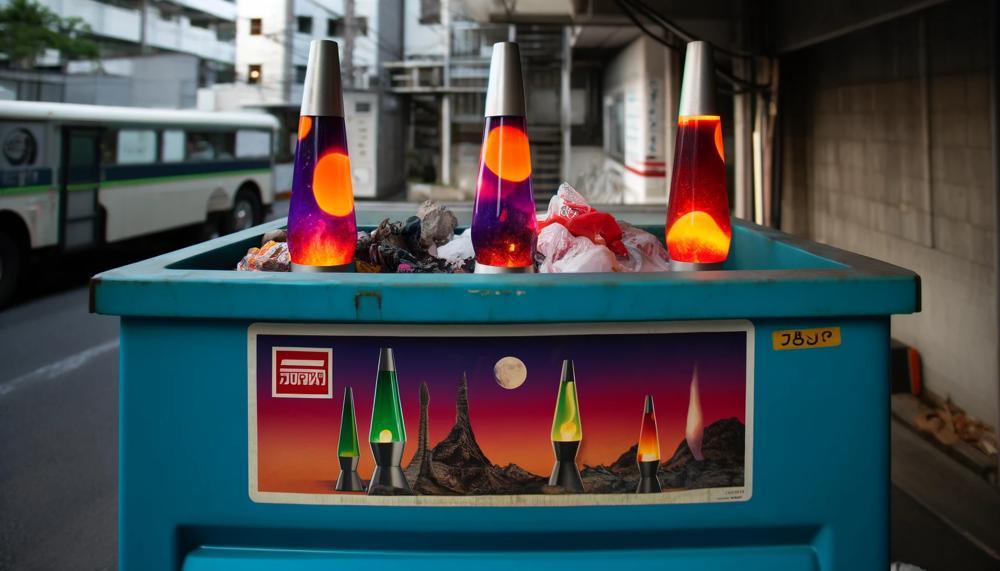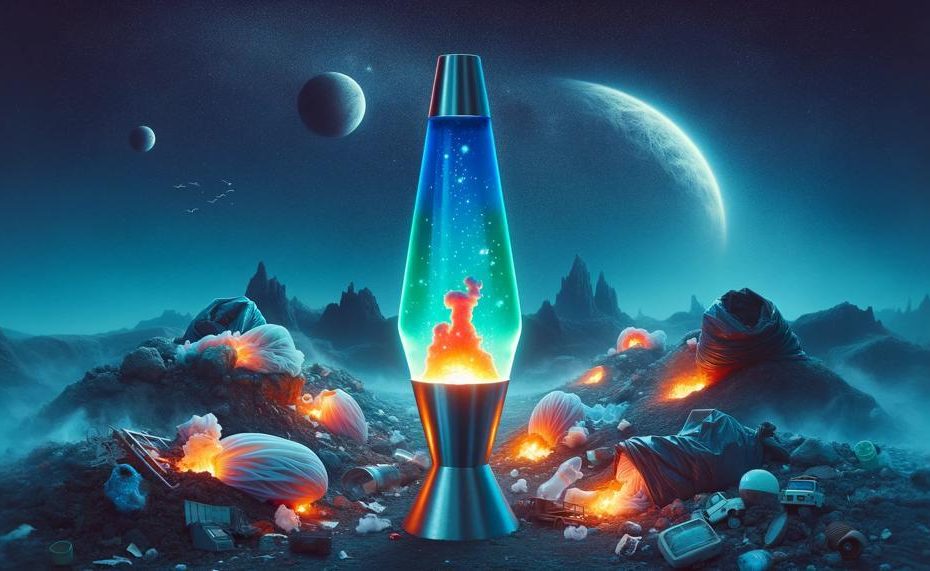In the kaleidoscopic world of home decor, few items evoke as much nostalgia and visual appeal as the iconic lava lamp. With its mesmerizing flow of colored wax in liquid, it’s a piece that has illuminated rooms with a groovy ambiance since its heyday in the 1960s.
However, as with all good things, a lava lamp’s lifespan must eventually come to an end. Whether it’s no longer functioning or simply doesn’t fit your current aesthetic, the question of how to part ways with this unique item arises.
Disposing of a lava lamp, however, isn’t as straightforward as tossing it into the nearest waste bin. Given its unique composition and the potential environmental implications, responsible disposal is paramount.
So, how do you dispose of a lava lamp properly?
Because lava lamps can have dangerous chemicals in them, you can get rid of them for free at a place that collects home hazardous trash. You could also do these things:
- Make the lamp shine again: Use a sponge or bottle brush to get to the inside and rinse it with warm, soapy water. Rinse well to get rid of any leftover residue.
- Clean the glass: Make sure that there is no more water inside. You can dry it with a lint-free cloth or let it dry naturally.
- Either recycle it or throw it away: You can take the lamp to a thrift shop if it works. You should recycle the broken glass and/or plastic pieces. You can throw away the electrical parts with other technological trash. You need to wrap the sticky lava stuff in newspaper and throw it in the trash. You could also use the glass bottle again as a vase or decoration container.
For example, Mathmos says that you can safely get rid of the lamp by drilling a hole in the metal cap, pouring out the liquid, and recycling the bottle. But some brands might have carbon tetrachloride in them, which is deadly and should be thrown away as toxic trash.
So, let’s get started.
Contents
What is a Lava Lamp?
A lava lamp, that enchanting fixture, dances with blobs of colour in a hypnotic ballet. Crafted in the 1960s, it’s not just a light; it’s a spectacle of physics and chemistry.
What’s Inside?
A lava lamp is a globe of wonder, containing two main players: a special paraffin wax and a concoction of water mixed with oil, tinged with vibrant dyes
Here’s the secret; the wax and liquid are a meticulously balanced duo, with the wax designed to melt at the kiss of a lightbulb’s warmth.
The Magic Begins
Plug it in, and the show starts. The bulb at the base warms the bottom, stirring the wax into motion. As it heats, the wax becomes a dancer, lighter than the liquid around it, ascending gracefully.
Reaching the cooler realms above, it pauses, cools, and descends once more. This endless dance, rising and falling, is the soul of the lava lamp.
Choosing Wisely
Not all lava lamps are born equal. Their allure lies in the quality of their components. A well-crafted lamp uses top-notch wax and liquid, ensuring a mesmerizing dance that lasts. Thus, selecting a reputable brand is the key to a lasting spectacle.
Disposing with Care
When its dance ends, disposing of a lava lamp needs thought. With components that should not meet drains or unprepared bins, proper disposal ensures safety and respect for the environment.
A Table of Components and Care
| Component | Function | Disposal |
| Paraffin Wax | Creates the “lava” | Specialist recycling or hazardous waste facilities |
| Water and Oil Mixture | Liquid medium for wax dance | Specialist recycling or hazardous waste facilities |
| Glass Vessel | House of the spectacle | Recycling center if possible |
In essence, a lava lamp is more than a light; it’s a masterpiece of warmth, wax, and wonder. Its creation in the ’60s brought a psychedelic vibe into homes, a vibe that continues to enchant with its serene dance.
Are Lava Lamps Toxic?
Lava lamps, with their hypnotic dance of wax and light, hold a captivating charm. Yet, as enthralling as they are, they come bundled with a care manual not just for their operation but for their disposal too.
They’re a chemistry set in motion, a blend of wax, water, oil, and sometimes a dash of added chemicals for color and density adjustments.
Potential Toxic Materials in Lava Lamps
| Component | Potential Toxicity | Concern |
| Wax and Liquid Mixture | Chemical additives | Can irritate skin, eyes, and, if ingested, the digestive tract. |
| Glass Body | Broken glass | Physical hazard that can cause cuts. |
| Electrical Components | Metal and plastic | Fire hazard if improperly handled or disposed of. |

Safe Disposal of Lava Lamps
To ditch your lava lamp without drama, here’s the lowdown:
- Don’t bin it whole: Chucking it in the rubbish bin as is isn’t the way to go. That’s a missed opportunity for recycling, and if it breaks, you’ve just turned your bin into a hazard zone.
- Recycle what you can: The glass and metal bits? Recyclable. Give them a new lease on life by separating them from the mix.
- Handle with care: If it breaks, glove up. Glass shards don’t discriminate, and you’d rather not find out how sharp they can be firsthand.
- Chemical disposal: For the waxy, colorful insides, your local hazardous waste disposal site will take it from there. They’re the pros at making sure it doesn’t end up harming the environment.
Keep it Out of Reach
Lava lamps aren’t toys, even if they look like they belong in a playroom. Keep ’em up high, far from the curious hands of children and the paws of pets. They’re for your eyes, not for touching or tasting.
The Disposal Process:
Disposing of a lava lamp involves a series of precise steps aimed at ensuring safety and environmental protection. Given the unique composition of these enchanting items, one must handle them with care, keeping in mind the potential hazard they pose if not disposed of correctly. Here’s a straightforward guide:
| Step | Action | Details |
| 1 | Preparation | Unplug the lamp, let it cool, and don protective gloves. Wrap the cord around the base to avoid tangles. |
| 2 | Disassemble | Carefully open the lamp to access the liquid and solid components inside. Proceed with caution to avoid breakage. |
| 3 | Dispose of Liquid | Pour the mineral oil into a suitable container. Ensure this is done away from any open flames or electrical circuits to prevent accidents. |
| 4 | Recycle or Repurpose | Consider recycling or repurposing the mineral oil if possible. If not, take it to a hazardous waste facility for proper disposal. |
| 5 | Cleanup | Use absorbent materials like newspaper or trash bags to clean any spills. Ensure the area is well-ventilated. |
| 6 | Disposal of Solid Parts | Dispose of the glass and any metal parts separately. Check with local recycling centres to see if they accept these materials. |
| 7 | Recycle Electrical Components | The base, cord, and bulb can often be recycled. Contact local facilities to find a suitable location for these items. |
Safety Requirements:
Disposing of a lava lamp demands a bit of know-how to dodge harm’s way. It’s not just about chucking it in the bin; there’s a proper method to ensure you’re not causing a stir in the environment or putting yourself in a pickle.
| Action | Do’s | Don’ts |
| Initial Step | Turn off and unplug | Handle while plugged in |
| Protective Gear | Wear gloves and goggles | Handle with bare hands |
| Disposal Method | Take to hazardous waste facility | Throw in regular trash |
| Drain Disposal | Avoid at all costs | Pour down sink or drain |
| Cleanup | Use paper towels, seal in bag | Leave spilled contents |
Remember, these steps aren’t just about keeping your conscience clean; they’re about safeguarding you and the planet.
Risk Factors for Handling and Disposal:
Handling and chucking away a lava lamp ain’t just about saying goodbye to a groovy light source; it’s a task needing a bit of know-how to dodge some gnarly risks. So, let’s dive into the nitty-gritty, folks.
| Risk Factor | Why It’s Risky | What’s the Worst That Could Happen? |
| Environmental Impact | The goo and juice inside these lamps can be proper nasty for Mother Nature. | Tainting the soil, messing with water critters, and giving plants a hard time. |
| Fire Hazards | If the lamp gets a bash or isn’t tossed out right, you could end up with a mini bonfire. | A surprise fire show nobody asked for. |
| Injury Risks | The glass bits can turn rogue and go all shardy on you. | Ouch. A trip to the ER with a tale about a lamp gone rogue. |
| Hazardous Waste | This isn’t your everyday trash; it’s got a vibe that says, ‘Handle me with care.’ | Getting on the wrong side of Mother Nature and possibly the law. |
| Improper Disposal Methods | These lamps don’t jive with the regular bin crew. | Landing in a pickle for not ditching it right. |
| Spills or Leaks | Slip-ups can lead to the lamp’s innards making a break for it. | A mini environmental crisis in your own backyard. |
When you’re gearing up to bid adieu to your lava lamp, remember it’s not as simple as chucking it in the bin. Think about the critters, the greenery, and yep, your own hide too.
The lamp’s got some quirks that need handling with a bit of finesse and know-how.
How To Dispose Of A Lava Lamp:
Disposing of a lava lamp requires careful handling and knowledge of local disposal regulations to ensure safety and environmental protection. Here’s how to do it right:
| Step | Action | Notes |
| 1 | Preparation | Unplug and let the lamp cool. Wear gloves to avoid any injury. |
| 2 | Disassembly | Remove the light bulb and any detachable parts. These can often be recycled separately. |
| 3 | Draining | Carefully pour the liquid contents into a container. Avoid spills by doing this over a sink. |
| 4 | Disposal of Liquids | Do not pour down the drain. Take it to a hazardous waste facility or follow local guidelines for chemical disposal. |
| 5 | Recycling Glass and Metal | The glass bottle and metal base may be recyclable. Check with your local recycling center. |
| 6 | Cleanup | Any spills should be cleaned with a mixture of soap and water. Ensure no residue is left behind. |
| 7 | Final Disposal | Wrap any sharp edges in newspaper or bubble wrap to prevent injury. Mark the container as “hazardous” if needed. |
Remember: Always check with your local waste management authorities for specific guidelines related to hazardous waste disposal.
Environmental Considerations:
Improper disposal of a lava lamp poses significant environmental risks. These quirky decorative items, if not discarded correctly, can unleash a cocktail of harmful chemicals into our ecosystem.
Chemical Contamination:
The enchanting liquid inside a lava lamp isn’t as harmless as it appears. When a lava lamp finds its way into a landfill as a whole unit, the chemicals encased within can seep into the earth, polluting the soil and potentially reaching groundwater sources.
This contamination can have a domino effect, affecting not only land and water but also the flora and fauna that depend on these resources.
Toxicity to Wildlife:
The contents of a lava lamp, particularly the wax and oil, contain substances that can be toxic to wildlife.
If these materials leak into the environment, they can pose serious risks to animals, potentially affecting their health or even leading to fatal outcomes.
Waste Management Challenges:
Lava lamps are more than just their liquid contents; they include glass and electrical components that require careful handling. Improper disposal adds to the burden on waste management facilities and complicates the recycling process, leading to inefficient use of resources and increased environmental strain.
Safe Disposal Practices:
To mitigate these environmental hazards, it’s crucial to follow safe disposal practices. This involves separating the lava lamp into its components – liquid, glass, and electrical parts – and disposing of each according to local environmental regulations.
| Component | Disposal Method | Environmental Benefit |
| Liquid | Dispose of as hazardous waste | Prevents soil and water contamination |
| Glass | Recycle | Reduces landfill waste |
| Electrical Parts | Dispose of at designated facilities | Prevents toxic leachate |
By adopting conscientious disposal practices, we can significantly reduce the environmental footprint of discarding lava lamps. It’s not just about getting rid of an unwanted item; it’s about ensuring that our actions today don’t become a liability for the environment tomorrow.
Are Lava Lamps Recyclable?
No, lava lamps cannot be recycled. Their unique construction and the mixture of materials they contain make recycling a non-viable option. Here’s why and what you might do instead:
The Materials Inside
- Glass Casing: While glass is generally recyclable, the glass in lava lamps is often treated with chemicals to withstand the heat, complicating the recycling process.
- Liquid Contents: The mesmerizing liquid is a concoction of mineral oil, wax, and other chemicals, which are not only non-recyclable but could be harmful if not disposed of correctly.
- Metal Coil: This is made from a blend of metals that are difficult to separate and recycle efficiently.
What to Do With Old Lava Lamps
| Action | Explanation | Where |
| Proper Disposal | Since recycling isn’t an option, disposing of lava lamps correctly is crucial to prevent environmental damage. | Local waste management facility or hazardous waste disposal center. |
| Donation | If the lamp still works and is in good condition, consider donating it to give it a second life. | Thrift stores, charity shops, or community centers. |
| Manufacturer Return | Some manufacturers might accept old lava lamps for proper disposal or recycling of parts. | Check with the lamp’s manufacturer. |
Remember, while the vibrant glow of a lava lamp can bring life to any room, its end of life requires careful consideration. The blend of its components, while not fitting the recycle bin, underscores the importance of thoughtful disposal.
Head to your local waste facility with your old friend or, if it’s still shining bright, pass it on to someone who can appreciate its glow.
Conclusion
Giving away a lava lamp in a responsible way is more than just getting rid of junk; it’s an act of environmental care.
With their rhythmic movements and flowing colors, these famous home décor items are more than just pretty to look at. They hold a piece of history and a mix of materials that need to be carefully separated and thrown away. Knowing how to safely dispose of your lava lamp’s parts is important.
When you’re ready to say goodbye to a lava lamp, you should carefully take it apart, make sure that the liquids and solids are thrown away in the right places, and recycle any glass or metal parts that you can. This process not only honors the lamp’s long life, but it also protects the earth and proper trash management.
It shows that we value our things more deeply and see them not just as temporary things that interest us, but as part of a bigger, more complex system that includes our natural surroundings.





